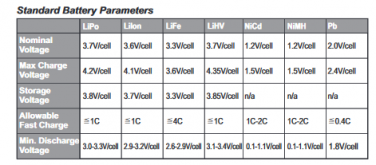Hello!
I hope my ordered 280ah cells will arrive in a few days.
I have no power supply like you use, but I have a charger which also habe a LiFe-Mode.
Do you think it is possible to top balance with this charger https://www.skyrc.com/iMAX_B6mini_Charger
I can set it to LiFe-Mode and choose only 1s.
If I look in the manual, I can find this table.
So, all cells in parallel and the charger set up to 1S it should charge with 3.3V - 3.6V (Nominal 3.3V and Max 3.6V)
Should it work for top balancing? OK, it could take a while with only 6A max. current.
I hope my ordered 280ah cells will arrive in a few days.
I have no power supply like you use, but I have a charger which also habe a LiFe-Mode.
Do you think it is possible to top balance with this charger https://www.skyrc.com/iMAX_B6mini_Charger
I can set it to LiFe-Mode and choose only 1s.
If I look in the manual, I can find this table.

So, all cells in parallel and the charger set up to 1S it should charge with 3.3V - 3.6V (Nominal 3.3V and Max 3.6V)
Should it work for top balancing? OK, it could take a while with only 6A max. current.


